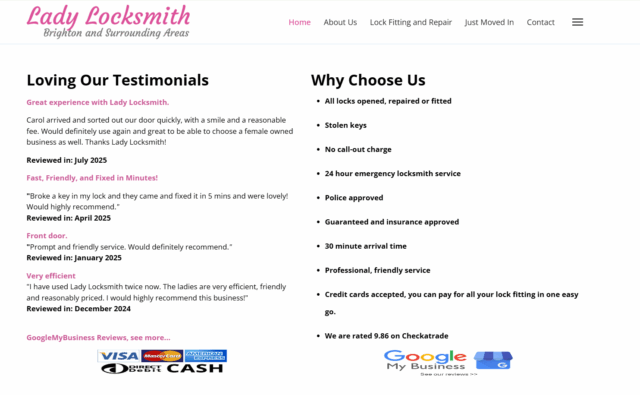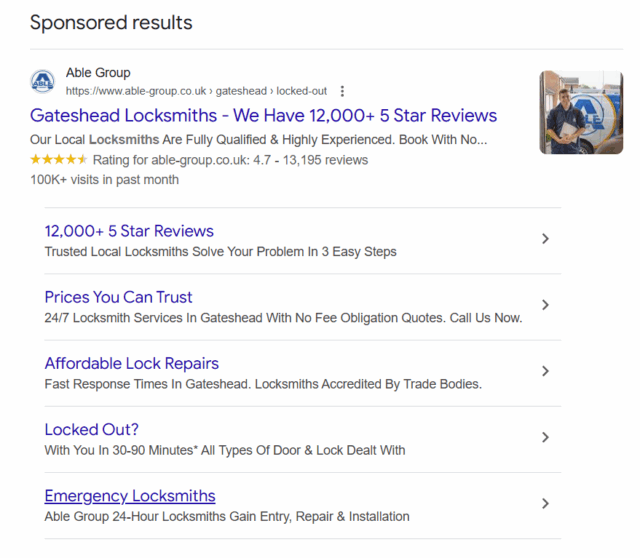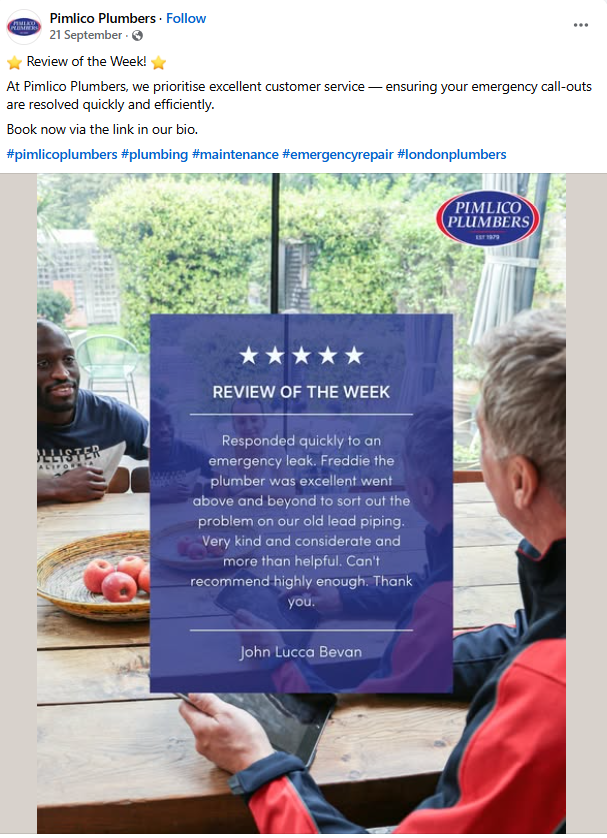
How to Repurpose Reviews Across Marketing Channels
Last updated on November 25th, 2025
68% of consumers only look at reviews posted within the last three months. So what happens to all your older positive reviews that you’ve worked so hard to get?
Online reviews don’t just belong on your business listings. When shared across multiple marketing channels, they can have a wider impact on trust, decision-making, and ultimately, purchases. By repurposing reviews, they can have a longer shelf life and make a bigger impact on customers at different stages of the marketing funnel.
In this blog, we’ll explore how you can maximize your online reviews across off-site marketing channels, including emails, ads, social media, print, in-store, and more. By using reviews strategically, you can turn every positive testimonial into a powerful marketing asset that reaches more people and keeps your reputation top of mind.
Step-by-Step: Turning Reviews Into Marketing Assets
To make the most of your reviews, it helps to follow a clear process. The eight steps below walk you through everything from auditing your existing reviews to creating assets, measuring performance, and keeping your content up-to-date. This gives you a repeatable process that you can rely on each time you want to bring your review marketing to life.
1. Audit Your Reviews
Start by collecting your reviews from each platform so you can see all the reviews you have to choose from. You could do this in a spreadsheet or Word document, or by connecting your reviews to a review management tool that collates all your reviews for you.
A thorough audit helps you understand what you already have and where there may be gaps. If one of your key services, products, or USPs is missing from your reviews, you may want to focus on generating more reviews first.
2. Choose Which Reviews to Repurpose
Once you have a clear picture of your reviews, select the ones that you want to repurpose in your marketing. Highlight reviews that are relevant to your audience and your offering. If you offer multiple services or products, choose reviews that cover each to avoid confusing potential customers. Some services may be better used on certain channels.
Pick a variety, including some with lots of detail, and some with short soundbites that would work on other channels. Avoid heavily editing reviews, but you may need to pull out sections of longer reviews, as lengthy reviews may not work on all channels.
3. Ask Permission
Even though a customer has chosen to leave you a public review, it doesn’t necessarily mean you can do what you want with these.
While it isn’t illegal to reuse reviews, it is best practice to ask for permission, especially if you are using the reviewer’s full name or photo, or cutting the review down in size. Seeking permission means no surprises for the reviewer later down the line when they see their name in lights.
Don’t use reviews where there is information that could violate a customer’s privacy, even if this is information they have shared themselves. This is especially true for healthcare providers or financial institutions that are subject to specific laws relating to online reviews.
4. Map Reviews to Channels
Next, decide which reviews work best for each marketing channel. Punchy quotes work well for social media and paid ads where space is limited, while longer testimonials may perform better in emails, blog posts, or print materials.
Matching the message to the right channel can help connect with your audience at different stages of the buying process. Reviews focused on your offering and customer support may work well for top-of-the-funnel marketing assets, while specific reviews on products or services could help get customers that are close to buying over the line.
Not sure which channels you could use? Keep reading and we’ll explain your options.
5. Design Assets
Time to get designing! Turn your chosen reviews into marketing assets such as social media graphics, videos, or print materials. You may choose to hire a designer to help with this, or tools like Canva can go a long way in creating simple on-brand assets that fit different channels.
Include the star rating, review platform name, and reviewer’s name, where possible to add social proof. If you can, include a link back to the review platform so readers can check the source and feel sure you’re being truthful in your marketing. Don’t over-edit or embellish the review content, as this will harm trust in your business.
6. Measure Performance
Before hitting ‘Publish’ on your review marketing, think about what success looks like for you. If you’re already running campaigns without review social proof, compare these to your new review campaigns to understand what works best.
Look at engagement, click-through rates, and conversions to see how your review marketing is landing. If the marketing channel you use doesn’t have simple measurement options, consider adding trackable links using tools like Google Tag Manager, BitLy, or HubSpot to see how your campaign is performing.
7. Refresh and Rotate
Reviews are not a one-time asset. While the shelf-life of a review can be extended by using it in your marketing, old or outdated reviews can make your business seem stale or make customers think you have no recent successes to shout about.
Continue to ask for new reviews, and update your marketing materials regularly with these. Using the same reviews over and over can have a diminishing effect, with customers less influenced by seeing the same review multiple times.
If you’re using your overall star rating from a specific review platform, make sure this is automatically updated, or if that’s not possible, manually update this frequently. If what a customer sees doesn’t match the truth, they may feel that you have misrepresented your business, even if it was true once upon a time!
Choosing Marketing Channels for Review Marketing
Once you’ve nailed your review marketing strategy, it’s time to decide where they’ll make the biggest impact. Different marketing channels reach people at different stages of the customer journey, so choosing the right mix helps your message land at the right moment.
Review Sites
Of course, potential customers will read your reviews directly on review platforms like Google, Yelp, and Facebook. Keep your profiles up-to-date, respond regularly to reviews, and monitor closely to be aware of what customers are saying about your business.
Unlike local business websites, business listings can use review schema, so this may be your best chance of getting those elusive stars next to your business name in search results.
Your Website
Your website is where potential customers go to learn about your business from the source. It’s the best place to tell your story in your own words, without third-party influence. You can showcase reviews directly on your website by embedding them in key pages like your homepage, service pages, or contact page.

Many review management tools offer review widgets that can show your best reviews on your website by pasting a small bit of code. It’s also powerful to use reviews in the places where customers are making decisions on your website, for example, next to enquiry forms or pricing pages. This social proof helps to reassure customers that what you’re saying about your business is backed up by the experiences of real people.
Paid Ads
Reviews can make a big difference in paid campaigns on social or search. Short quotes or star ratings can help your business stand out, and instantly tell searchers what makes your business unique.

Keep the messaging authentic and relevant to the ad’s goal. Ads often have little space to impress a potential customer, so make any quotes short and sweet. Ads on social media often work best as part of a larger campaign, rather than being the first thing a potential customer sees of your business.
Social Media
Social media is ideal for sharing reviews in an engaging and visually appealing way. Turn reviews from happy customers into posts, stories, or even short videos paired with visuals of your business in action.

Regularly sharing reviews on social media gets your best feedback seen by a wider audience, but also may encourage customers to write a review for you with the hope that their message will get shared too!
Email Marketing
Email is often an underappreciated channel for many local businesses. The best thing about email is that the audience is already engaged in your business, as they will have chosen to opt into hearing from you.

Including reviews in emails adds credibility to your messages and can help move subscribers toward action. Add reviews to your welcome emails, newsletters, or include a short quote in your email signature. Featuring reviews in emails reminds your audience of real customer experiences.
Case Studies
Reviews are a great way to identify happy customers who may be willing to share their experience in more detail. Identify positive feedback and contact those customers directly, or reply to their review and invite them to get in touch if you don’t already have their details. This can lead to rich case studies built from genuine customer experiences.
Case studies let you showcase the entire customer experience from start to finish. They provide credible content that can be used across marketing channels to give potential customers a clear idea of the value your business offers.
Printed Marketing Materials
Online reviews also have a strong use in offline marketing. Share reviews in printed marketing materials such as brochures, flyers, or even as part of adverts in local magazines or newspapers.

Featuring short, genuine quotes and star ratings in print builds credibility with potential customers who may not yet be aware of your business, and extends the reach of your online reputation to offline channels.
Invoices, Receipts, and Packaging
Every customer touchpoint is an opportunity to build trust. Including reviews or star ratings on invoices, receipts, or packaging reminds customers of the positive experiences of using your business and encourages repeat business. These may even translate into more reviews.
In-store Displays and Signage
For businesses with a physical location, in-store displays and signage are great ways to showcase reviews. Displaying customer quotes and star ratings from top review sites on walls, windows, or posters reassures visitors that you stand for good customer service.

But be aware, it may be harder to regularly update reviews that are printed and on display. It may be best to avoid printing overall star ratings, numbers of reviews, or dates of reviews as these can go out of date very quickly. Also, be aware that if a review talks about a service or product that you later stop providing, or a staff member who later leaves, you may need to update the in-store signage.
Keep Your Reviews Working Harder
Your reviews are more than just testimonials on a listing; they’re powerful marketing assets. By sharing reviews across online and offline marketing channels, you can extend their reach, longevity, and influence.
To keep this impact growing, make review marketing part of your regular workflow. Continue collecting fresh feedback, monitor your profiles, and update your materials so everything stays accurate and relevant. The more consistently you use your reviews, the more they will work for you by building trust, supporting conversions, and showcasing the great experiences your customers have every day.